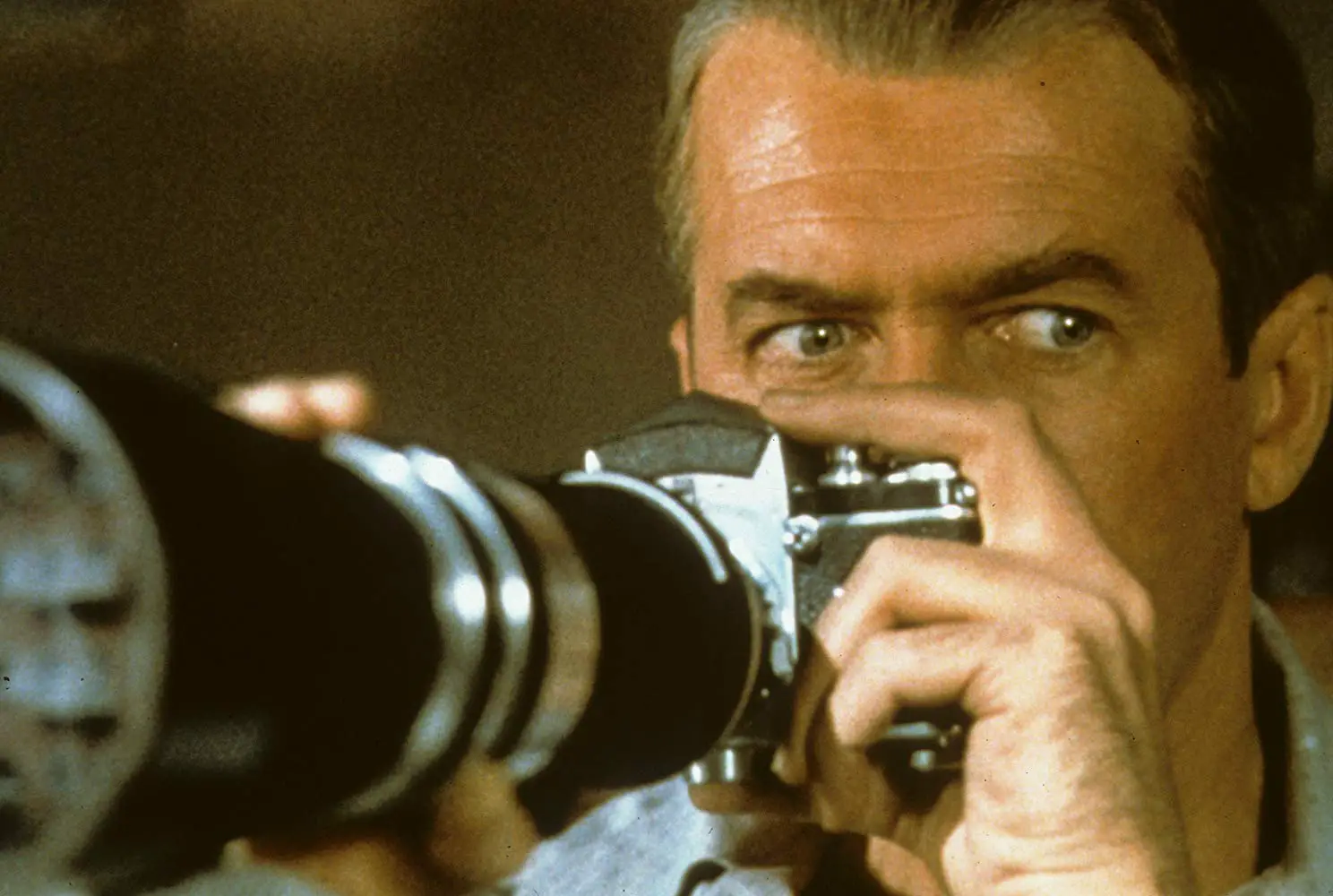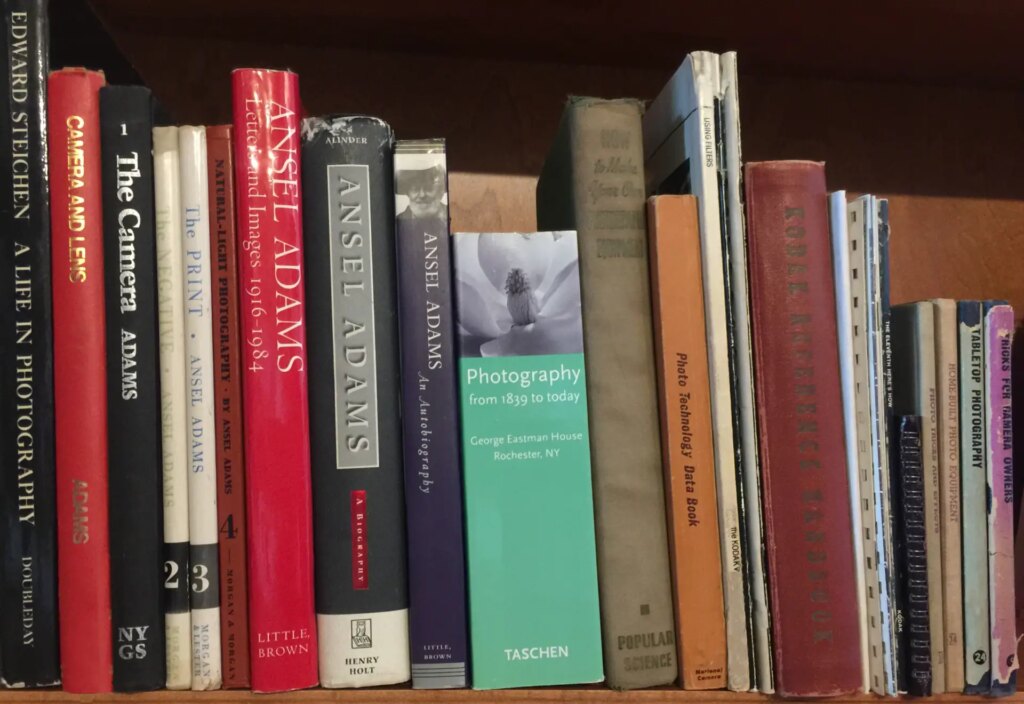Rear Window is a great movie, and taking photographs is the main character’s essential trait. Francois Truffaut, whose book turned director Alfred Hitchcock the man into one-name “Hitch” the myth, praised this screenplay as the best of all. L.B. Jeffries, enacted by Jimmy Stewart, is a foreign correspondent who has traveled the world but now finds himself laid up with a broken leg. Bored even/especially by his socialite-fashion model girlfriend, Lisa Fremont, played by Grace Kelly, he whiles away his days staring across the courtyard at his neighbors going about their business.
Released in 1954 and restored to Technicolor glory in 2000, the cinematic masterpiece is based on a short story by neglected noir writer Cornell Woolrich as adapted by repeat Hitchcock collaborator and eventual victim John Michael Hayes. The community, such as it is, is based on an actual Greenwich Village block, recreated on a massive set. Jeffries — called “Jeff” by his female companion — is a temporary voyeur.
Critics explain that we, the audience, are trapped alongside him in his apartment, experiencing exactly what he does, from his point of view. The “everyman” appeal of Jimmy Stewart, who was the Tom Hanks of his era, keeps the character from coming across as a total creep despite a bit of leering. Stewart also starred in the director’s Rope, The Man Who Knew Too Much, and Vertigo.
Such is the skill of Hitchcock that we are willing to accept the proposition that most New Yorkers rarely draw their curtains or lower their blinds. Appropriate use of window treatments would ruin the thrill. The express explanation is that, in the dog days of summer before the spread of air conditioning — the Rivoli Theatre on Times Square had introduced Willis Carrier’s invention in 1925– fenestration was the only means for cooling. As surprisingly, the observed fail to notice the observer, even as he peers through binoculars straight at them, putting them under his around-the-clock surveillance. Hitchcock was coming off the success of Psycho, which involved its own perversions.
Jeffries has his bona fides established efficiently. He was the leading photojournalist for a magazine similar to Life or National Geographic, enjoying an expense account on his adventures, when people still subscribed to glossy periodicals for exotic pictures. The relationships are asymmetrical: Jeffries knows those who are ignorant of him.
He has named his current subjects by what he can perceive. There is Miss Torso, who entertains, and Miss Lonely Hearts, who is not entertained. His problems arise when he speculates from circumstantial evidence that a traveling salesmen (Raymond Burr) might have killed his disabled wife. Although he has become familiar with the inhabitants of a building that presents drama sufficient to entertain him while he recuperates, this particular development is intriguing even if initially dubious.
The issue is that he realizes he ought to do something, not remain inert. But he can act only through surrogates.
The temporary invalid must have the most comprehensive health insurance available. He is paid a daily visit by a no-nonsense masseuse nurse. She discourages his hobby, advising him about the penalty for being a Peeping Tom, and encourages his courtship, counseling him on the virtue of marriage.
Both of the women in Jeffries’s life start off skeptical, but each comes around in turn to sharing his suspicions. Fremont tells her gentleman caller, who routinely rebuffs her affection without so much as a glance, that he is “diseased,” and then based on what is referred to as feminine intuition becomes convinced that the missing wife in fact is a deceased wife. Nurse Stella (no last name) is soon explaining the blood splatter that would have to be cleaned up. Together they break into the perpetrator’s apartment. That sets up the climax when the wheelchair-bound photographer is confronted by the now-conclusively-established murderer.
The most affecting character of all is the little dog, beloved by a couple who live several floors above ground. They have trained the canine to ride up and down from the fire escape in a little basket drawn by pulleys, in order to do his business and then return home. The tragedy of the movie is the death of the pup, more than the murder of the human victim because the personality of the former is more apparent than that of the latter and the helpless woman merely functioned to set the mystery in motion. That crime against man’s best friend confirms the original homicide. In a reversal of the Sherlock Holmes case in which the clue is the dog who did not bark in the nighttime (because he was acquainted with the wrongdoer), here the tipoff is the human who was not curious about the commotion. Only one individual fails to look at the terrible sight of the lifeless animal — of course because he was responsible for that fate. The scene is the only one to occur outside of the confines of Jeffries’ apartment.
Photography runs throughout. It is integral to the plot. Jeffries behaves naturally as a professional at the top of the business. He was injured while witnessing some sort of race car crash. He is allegedly based on Robert Capa.
Jeffries spies using a monster telephoto lens, the brand name covered by gaffer’s tape before “product placement” had been turned into a regular practice. However, the manufacturer, Exakta, ran print advertisements with the headline that Hitchcock had selected them. At 400mm (from a range that spans from 28mm to 800mm), the glass has to be balanced on Jeffries knees to be stable, since his condition precludes use of a tripod.
He shoots slide film. He views a transparency to determine that a flower bed has been dug up. Presumably something (not enough room for it to be someone) has been buried underneath.
Most spectacularly, he fends off an attack with his flash gun, depriving his opponent temporarily of what he himself has been reduced to — vision. He is desperate, but resourceful. Without his equipment, he would have been a goner.
Rear Window is of its time. Jeffries and Fremont are about as chaste as a couple could be. He would rather watch others than canoodle with her. There are not many modern movies in which, without a hint of self-consciousness, the characters drink brandy from snifters, inviting a law enforcement officer to join them. The movie has become a cultural icon. There was a television remake with the late Christopher Reeve, after he was actually paralyzed, in 1998; and an homage entitled Disturbia, featuring Shia LeBouf, ruled by a court not to be plagiarism. Brian de Palma’s outrageous 1984 Body Double mashes together Rear Window with Vertigo.
This is a film that appears on so many “best of” lists one need not have any interest in photography to be enthralled. Yet it should be especially compelling for anyone with even a modicum of enthusiasm for the art. It is about our responsibility for what we see.
Correction. A reader pointed out Rear Window was released before Psycho, not after. That is the beauty of the internet. I am corrected. The reader is absolutely right. I figured out the cause of my error though: back in the day (and I am old enough to remember!), studios re-released their movies from time to time. This is before streaming, DVD, VHS, and even TV broadcast, so you could see a hit only if you went to a theatre. To be thorough in research, I went back and watched multiple trailers for Rear Window. One of them was for the re-release, not the theatrical premiere, and it carried a note at the end about Psycho — Rear Window must have been brought out again a few years to capitalize on the popularity of Psycho. I was misled, so many thanks to those more careful.
Share this post:









Comments
Dan Castelli on Hitchcock’s Rear Window – Watching the Watcher – By Frank H. Wu
Comment posted: 27/07/2018
I was told by a film historian that the character played by Jimmy Steward in 'Rear Window' was actually based on David Douglas Duncan (who recently died in France at 102) and Capa. The reference to DDD is a framed photograph on the back wall of Stewart's apartment. It shows a wartime pic of an American P-38 fighter plane. During WW2, Duncan (who was a USMC photographer) was flown over the battle of Okinawa while suspended in a modified external fuel tank with a clear Plexiglas nose. The plane he was flying in/under was a P-38 photo recon fighter.
Graham Orbell on Hitchcock’s Rear Window – Watching the Watcher – By Frank H. Wu
Comment posted: 27/07/2018
Around about 1970 (as a cameraman) I filmed a TV interview with Raymond Burr, when he discussed working with Hitchcock in Rear Window as well as the then current TV drama series “Ironside” where Burr was a wheel chair bound courtroom lawyer. Burr was then transiting NZ flying between USA and Australia in the days when a refueling stop was necessary.
I had years ago used but not owned the Exacta camera as in the movie. It was beautifully made but quite complicated without an instant return mirror. As I remember; to engage slow shutter speeds there was an additional switch to operate. If that was not returned after using slow speeds, it messed up the fast shutter speeds. At the time ( late 1950s /early 60s) I preferred and owned the more simple Asahi Pentax S1.
This reminds me of another old movie, “Blow Up” where a photographer discovers a body in the background when he enlarges his negatives. I must try to chase that one up again.
Thanks again Frank for your review of Rear Window.
David on Hitchcock’s Rear Window – Watching the Watcher – By Frank H. Wu
Comment posted: 27/07/2018
I borrowed a friend's Exakta and the spinning and whirring is everything a steam punk could dream of.
Kodachromeguy on Hitchcock’s Rear Window – Watching the Watcher – By Frank H. Wu
Comment posted: 27/07/2018
Dean Markwardt on Hitchcock’s Rear Window – Watching the Watcher – By Frank H. Wu
Comment posted: 28/07/2018
oreston on Hitchcock’s Rear Window – Watching the Watcher – By Frank H. Wu
Comment posted: 28/07/2018
Just a small but I think historically important point: I'm sure Ihagee (manufactuers of the Exakta) traded on the use of the Exakta system in the movie but they were not lens makers. At the time they relied on Meyer Optik Görlitz and Carl Zeiss Jena, and less officially on the West German and wider European optics industry, to make lenses for their cameras. I believe the 400mm lens seen in the film was made by Kilfitt.
I think Rear Window is notable for giving an SLR camera (and one with a pentaprism finder at that) such a high profile in what was still largely a rangefinder dominated world (so far as 35mm was concerned). In 1954 the Pentax and the Nikon F were still several years in the future and the Exakta was about as good as it got. Of course the main reason for its use is that there was no way to use a 400mm lens on a Leica or a Contax.
Thursday Night Reading Room - News & Things you might have missed (Week 1 26th July to 2nd Aug) - Canny Cameras on Hitchcock’s Rear Window – Watching the Watcher – By Frank H. Wu
Comment posted: 02/08/2018
Andrew Fildes on Hitchcock’s Rear Window – Watching the Watcher – By Frank H. Wu
Comment posted: 22/05/2020